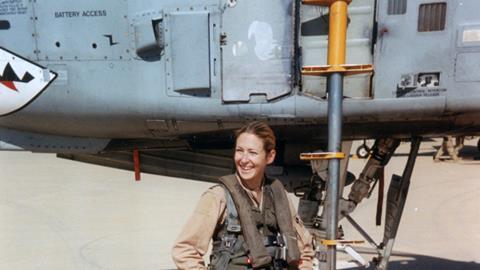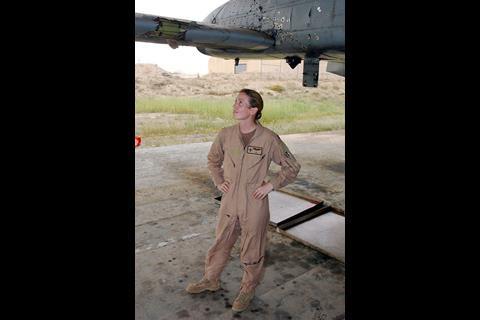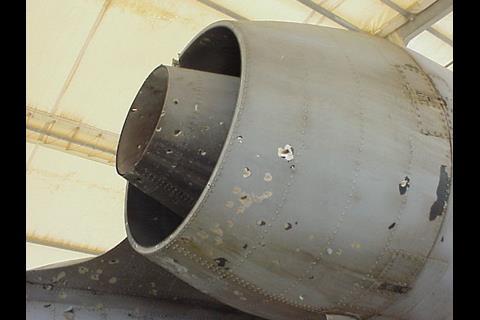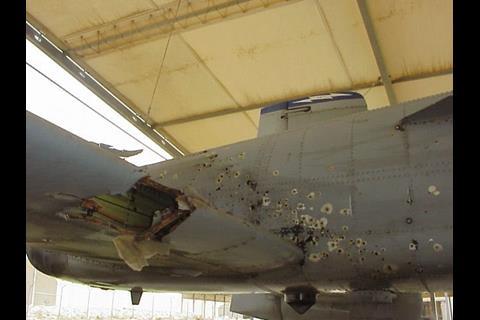A violent shudder rocked through the airframe, as a surface-launched missile slammed into the low-flying fighter.
Pulling out of a left-hand turn, Kim “KC” Campbell felt the impact behind her, as the Fairchild Republic A-10 Warthog was engufled in a ball of orange flames. The cockpit flight controls instantly went limp in Campbell’s hands.
“It really felt like I had no flight control at all,” the retired US Air Force (USAF) officer recalls, 20 years later. “I pulled back on the stick in that left hand turn and I just felt like nothing. Nothing was happening.”
A surface-to-air missile (SAM) had impacted the jet’s right horizontal stabiliser, sending shrapnel into the fuselage and completely severing the primary and back-up hydraulic lines.
It was April 2003 and Campbell’s A-10 fighter squadron was deployed to Iraq, providing air cover to American ground forces driving toward Baghdad. Her flight had responded to a call for help from US troops pinned down in the Iraqi capital, facing entrenched enemy forces.
After lining up a low-altitude attack run, Campbell, flying that day as callsign Yard 02, launched a salvo of rockets at the Iraqi position – pulling off just as the missile struck her jet.
In her memoir Flying in the Face of Fear, KC recounts the ensuing seconds.
“The jet rolls over to the left and points directly down at Baghdad… I can see the Tigris River getting closer… and I know I might have to eject,” Campbell recalls. “But the last thing I want to do is eject out of my airplane into the hands of the enemy.”
Although she now faced another life-threatening situation, Campbell survived the initial SAM, somewhat intact, thanks to her aircraft’s uniquely rugged design.
The Cold War-era A-10 was built to kill Soviet tanks in the plains of Central Europe. Designed around the iconic seven-barrelled Avenger 30mm cannon for directly engaging ground targets at low-altitude, the A-10 is made for surviving hostile ground fire.
A titanium “bathtub” surrounds the cockpit, and the fuel tanks are enclosed in fire-resistant foam lining. The GE Aerospace TF34-GE-100 turbofan engines are durable enough to survive extensive battle damage.
But what really saved KC over Baghdad was the aircraft’s triple-redundant, manual flight control back-up system.
“It’s fairly unique to the A-10s,” she notes.
Officially known as manual reversion, the system uses “old-school cranks and cables”, as KC describes it.
Those old-school cables provided only limited flight control, but allowed Campbell to regain control of her aircraft and pull out from that dive toward the Tigris. However, she still had to limp the nearly-crippled jet some 300nm (480km) over an hour of flying back to a friendly base in Kuwait.
If the manual flight system failed, Campbell would be forced to eject over the Iraqi desert into uncertain hands.
Even if Yard 02 made it back to base, landing under manual reversion would still be extremely risky. With no speed brakes or steering, the procedure was considered so dangerous that KC says it was not even practised in A-10 flight training.
Such a landing had only been attempted three times previously; producing one pilot fatality and two destroyed aircraft.
“I knew about those stories,” Campbell says. She notes A-10 pilots do train on manual reversion in simulators or flying at a safe altitude of at least 10,000ft.
“Just to get a feel for how it flies,” she notes, “because it’s heavy, it feels different.
“But we don’t try to land,” she adds. “It’s just too risky.”
A 1982 USAF investigation into the performance of A-10 pilots while under manual reversion found the system did offer an “added margin for survival”, but also created “unacceptable workload” for aviators during landing.
“Aircraft control in the manual flight mode is exceptionally demanding of piloting skills,” the report noted.
In the end, Campbell was able to bring her A-10 home – only the fourth manual reversion landing in history.
“I’ve struggled to find a word to describe it,” KC says of walking away from the combat experience. “Relief just doesn’t describe it.”
That relief was to be short-lived, however. The next day, Campbell was back in the air supporting a search and rescue for another A-10 pilot who had been shot down.
She would go on to a full career in the air force, retiring as a Colonel. Campbell’s A-10 from the Baghdad mission, tail number 81-987, was ultimately deemed too damaged to fly again. It was retired and is now on display at Seymour Johnson AFB in North Carolina.
The USAF is finally beginning to retire the A-10 from service – something service brass at the Pentagon have been attempting for years. Defence leaders cite the aircraft’s age and lack of survivability against modern air defences as not worth the cost of keeping the Cold War jet flight-worthy.
“It wasn’t designed for that high-threat environment,” KC acknowledges. However, she cautions against rushing to eliminate the Warthog’s powerful ground attack capability altogether. The troops below will always need close air support, she says.
Although Congress has largely prevented the USAF from downsizing its A-10 fleet, service leaders are still seeking ways to creatively use the aged jets.
In May, the USAF’s top officer in the Middle East announced A-10s upgraded to carry additional precision-guided bombs will deploy to the Persian Gulf region on a deterrence mission – a task usually reserved for newer multi-role fighters.
The type’s cult status among active-duty troops and veterans – a result of protracted ground wars in Iraq and Afghanistan – has significantly raised the A-10’s profile from the time when Campbell attended flight school in late 1990s.
“I couldn’t even find a poster of the A-10 to put on my wall,” she recalls after finding out she was selected to fly the Warthog. But Campbell says that changed as the type proved itself in combat.
“I think a lot of student pilots were realising that if they want to go do what they’ve been trained to do, then the A-10 was absolutely an airplane to go fly,” she says.
KC acknowledges the venerable jet has an uncertain future, in an era when the USAF is focusing on stealth capability and long-range precision munitions. However, the combat-tested aviator notes this is not the Warthog’s first brush with decommissioning.
“Every time there’s a conflict, the A-10 proves itself, but then after the end of the conflict we talk about getting rid of the airplane again,” she notes. “We prove ourselves when it counts.”
Campbell no longer flies the A-10. She retired from the air force in recent years, and in addition to writing now works as a public speaker and leadership coach.
She remains connected to aviation through those efforts.
“We have a responsibility as fellow aviators to keep each other safe,” Campbell says. “That means we share our stories, we share those experiences, even when they expose mistakes or weaknesses. Those stories can help make other people better and they can save lives.”
































